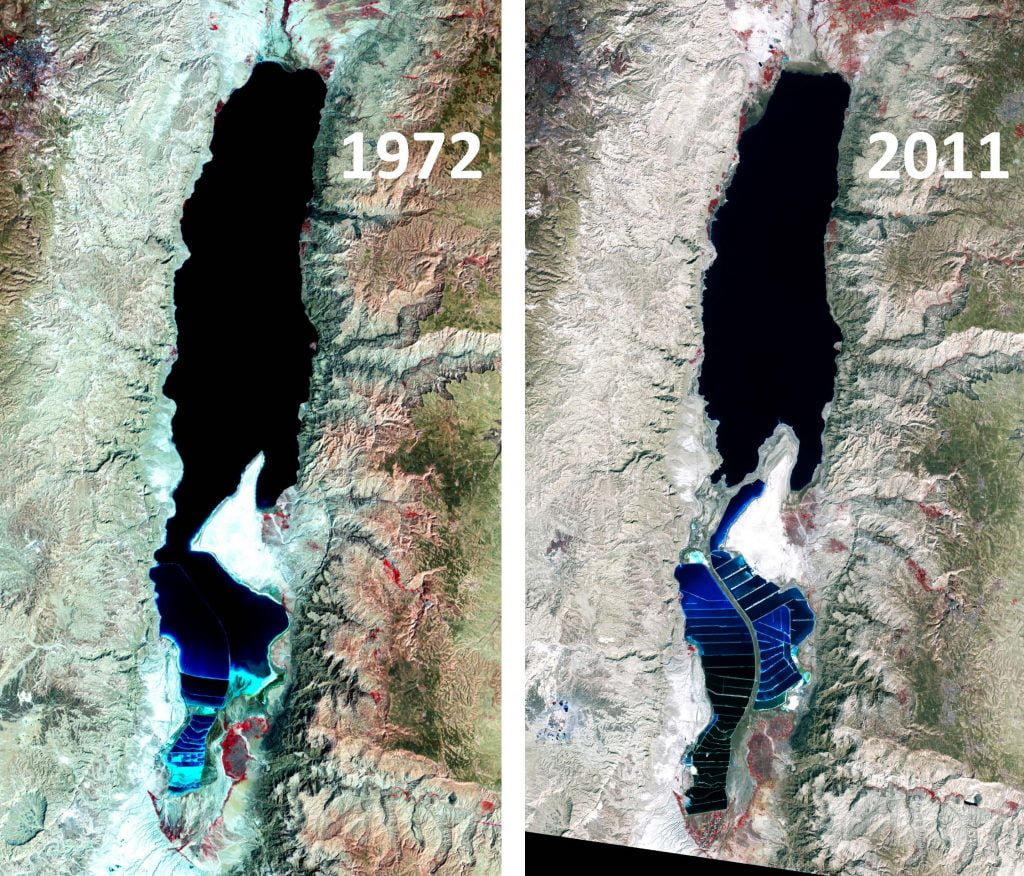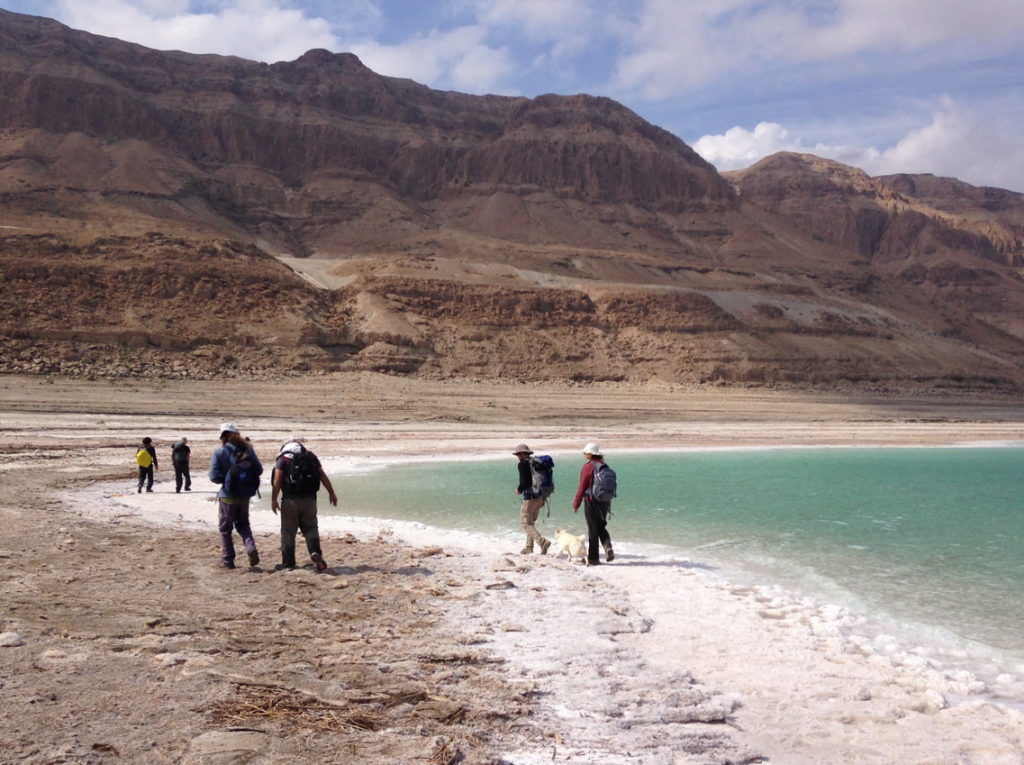As a top tourist destination, Israel welcomed a record-breaking 4.1 million visitors in 2018 and just over two million from January to May this year. Tourists flock to the country to seek its exciting array of sites, including ancient and historic cities, picture-perfect beaches, fabulous shopping, renowned museums, and countless hiking trails.
One of Israel’s most visited destinations is the famous Dead Sea, the lowest elevation on Earth at 430 meters (1,410 feet) below sea level. As the deepest hypersaline lake in the world, the Dead Sea, bordered by Jordan, Israel, and the West Bank, is a natural and historic wonder. There is no marine life in the lake due to its high salt concentration (which is how it earned its “dead” title in English). Visitors typically cover themselves in the lake’s mineral-rich mud, believed to hold healing properties for skin conditions, and float naturally and effortlessly in its waters.
SEE ALSO: Israel Reveals ‘World’s Longest Salt Cave’ In Mount Sedom Near Dead Sea
In recent decades, scientists have observed that a large amount of the freshwater that feeds the Dead Sea has been diverted, lowering the lake’s water levels and making it even saltier. This trend was first observed in 1979 when scientists noticed salt crystals precipitating, or “snowing,” out of the top layer of the sea’s water. This salt crystal “snow” has piled up on the lake bed, puzzling scientists across the globe as the sinking salt defies the laws of physics. The salt layer on the lake floor has been growing about 10 centimeters (four inches) thicker every year.
A salty mystery solved?
Now, some forty years later, scientists are unearthing the reason for this salt buildup. A new study published in the American Geophysical Union’s (AGU) journal Water Resources Research proposes that small disturbances in the Dead Sea, caused by waves or other motion create the “snow,” also referred to as “salt fingers,” that make their way down.
The study is a collaboration between researchers from UC Santa Barbara’s Department of Mechanical Engineering, the Geological Survey of Israel, and the Department of Geography and Environment at Bar Ilan University.
“Initially you form these tiny fingers that are too small to observe… but quickly they interact with each other as they move down, and form larger and larger structures,” said Raphael Ouillon, a mechanical engineer at the University of California Santa Barbara and lead author of the new study, in a statement.
“The initial fingers might only be a few millimeters or a couple of centimeters thick, but they’re everywhere across the entire surface of the lake,” said Eckart Meiburg, also a mechanical engineer at UC Santa Barbara and co-author of the study. “Together these small fingers generate a tremendous amount of salt flux.”
Nadav Lensky, a geologist with the Geological Survey of Israel and also co-author of the study, tells NoCamels in a phone interview that although “there are other water bodies that are very salty…they are all very shallow…we are talking about phenomenon occurring in deep strata, [and we] can only use the Dead Sea to study it.”

“The Dead Sea is only hypersaline water body on Earth today where this salt fingering process is happening, so it represents a unique laboratory for researchers to study the mechanisms by which these thick salt deposits have formed,” the authors said in a statement.
Lensky says the Dead Sea’s salt crystals are “strange and counterintuitive.” There is a general understanding among scientists that there is higher salt precipitation in dry seasons and lower salt precipitation in winter seasons. However, Lensky and his colleagues have discovered the opposite for the famous Dead Sea.
“During the summer, less dense, warm and salty shallow water overlies the denser deep water which is colder and less salty. In spite of this density stratification, our numerical simulations show that the water column can be unstable due to the different rates at which heat and salt diffuse…as this water cools, it loses its ability to dissolve the salt, so that salt crystals form and settle to the sea floor,” Lensky described.
Sign up for our free weekly newsletter
Subscribe
In other words, during the summer, extra heat warms the surface of the Dead Sea and divides it into two distinct layers: a warm top layer and a colder lower layer. As the water evaporates from the top layer in the summer heat, it becomes saltier than the cooler layer below. The researchers realized that the salt snow was originating in this top salty layer but they were puzzled as to how salt from the surface was entering the dense cooler layer and plummeting to the bottom of the lake.
In 2016, Lensky co-authored a study that proposed that as the top layer of the lake was being disturbed by waves or other motion, tiny parcels of warm water were entering the cooler pool of water below. Because heat diffuses more rapidly than salt, the warm water parcels were rapidly cooling but as they were doing so, they also lost saline concentration as the salt was precipitating out and forming crystals that were sinking to the bottom.
“They found the salt fingers theory correctly predicted the downward flow of salt snow and buildup of salt layers in the middle of the lake’s floor,” the authors said in the statement. Because of the lowering sea levels the salt layers are concentrated in the central part of the lake, according to the authors.
In the new study, first published in May this year, researchers were able to test Lensky’s hypothesis by developing a computer simulation of how water and salt would flow in the Dead Sea if the salt fingers theory was correct.
Lensky tells NoCamels the findings were reached rather quickly. Less than a year ago, he says he contacted Ouillon to explain his hypothesis on the Dead Sea phenomenon. Lensky says he knew that the solubility would be difficult to compute, but was confident that UC Santa Barbara “had the engineers” for the task, he explains.
The research, he says, was completed “very fast” because the group maintained “very good communication and understanding.” Lensky reflects that it has been an extremely “successful collaboration” which they plan to continue.
A larger study of Earth’s salt deposits
The new findings, according to the authors, will not only help researchers better understand the physics of the Dead Sea, but may also lend an explanation to the formation of massive salt deposits found within Earth’s crust.
“We know that many places around the world have thick salt deposits in the Earth’s crust, and these deposits can be up to a kilometer thick,” Meiburg said in the statement. “But we’re uncertain how these salt deposits were generated throughout geological history.”
The researchers offer the example of the Mediterranean Sea which has a thick salt layer.
About six million years ago, according to known research cited in the statement, the Strait of Gibraltar closed off due to the movements of Earth’s tectonic plates, cutting off the Atlantic Ocean from the Mediterranean, and creating a giant shallow inland sea. This led the Mediterranean’s water levels to drop so much that the sea partly or nearly dried out, leaving behind thick deposits of salt.
“The new finding suggests these deposits formed during this time in a similar manner to what is happening right now in the Dead Sea. When the Strait of Gibraltar opened up again, water flooded the basin and the salt deposits were buried under new layers of sediment, where they remain today,” the statement reads.
Related posts

Resilient And Nutritious New Plant-Based Milk Aims To Make A Splash

Chocolate From Cultivated Cocoa Comes Without Environmental Toll

Plastic Fantastic: Startup Takes PVC Back To Its Crude Oil Roots




Facebook comments